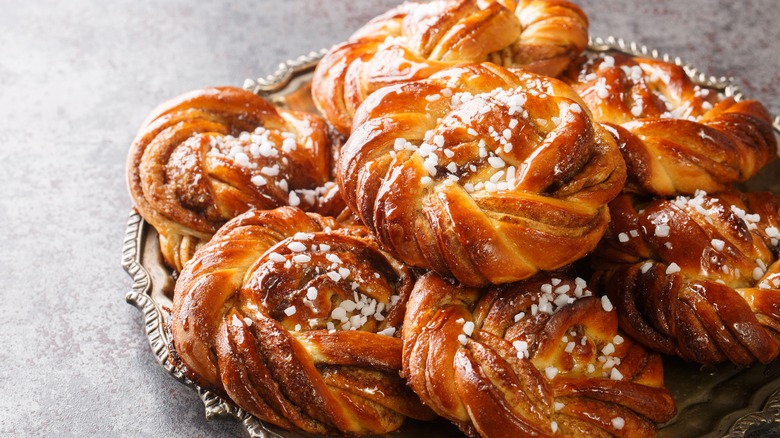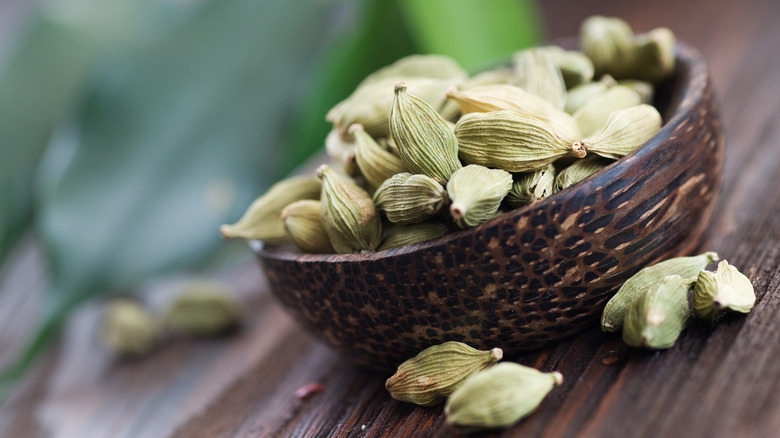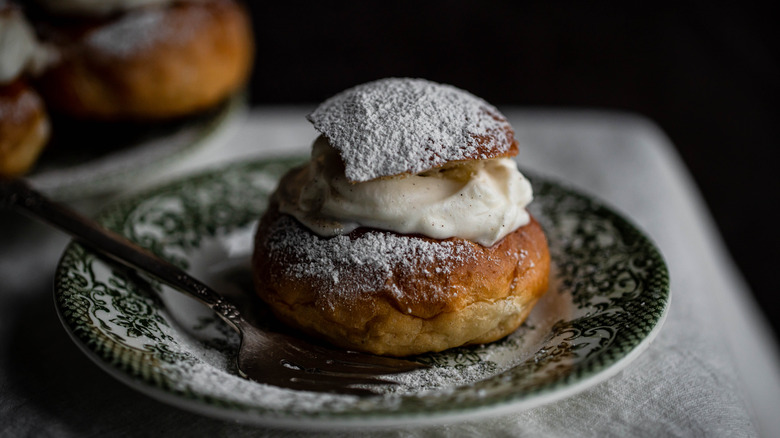Here's Why Cardamom Is A Star Of Scandinavian Baking
When you sit down to a fresh cardamom bun with your morning coffee, perhaps you feel as if you're enjoying a meal fit for royalty. You wouldn't be far off, considering that hand-harvested cardamom is a precious and pricey spice, mostly enjoyed throughout history by upper-class citizens who could afford such a luxury.
But you may not imagine that you're participating in the legacy of a different kind of historical figure — that of the Viking. And yet, if you trace the history of a Scandinavian style cardamom bun to its origins, there's evidence that these horned explorers may be part of the reason you have your treat in the first place. It's posited that these adventurous travelers came across cardamom during their European expeditions, back when the spice was making its way from India along the trade route with a stop in what is now Istanbul.
Some historians suggest an alternate story, however, that takes us back as far back as the 8th century (with recorded evidence cropping up later, in the 13th century). This one suggests it was Moorish influence — not Viking — that was responsible for the cardamom craze in Scandinavian countries. But regardless of how the spice arrived there, hundreds of years later Scandinavian cultures still center on this delicious spice's flavor, which has become especially well known for its prevalence in pastries.
The path to Scandinavian spice supremacy
The modern Scandinavians may not have much in common with their Viking forebears or the Moors of centuries past, but there are good reasons that they have continued to feature this tasty imported spice. For one thing, it can be grouped into what many cooks call "warming" spices (which also include cinnamon, clove, and ginger among them) — and that's an attractive quality in regions known for being quite cold.
That said, ayurvedic practice distinguishes between types of cardamom, believing that while black cardamom may indeed pack a little heat, the kind we normally find in the U.S. — green or white cardamom — has more cooling properties. These varieties have other distinctions as well; the main difference between white and black cardamom involves how they're harvested, with the latter being roasted and more potent, and the former more mild.
Regardless of variety, cardamom proliferates in Scandinavian culture largely due to its use in the wildly popular buns. Although these bready, chewy treats as we know them today are likely only about a century old, they've become a major part of the modern Scandinavian diet, especially since the middle of the 20th century when increased availability of the core ingredients made them more accessible from a price standpoint, and pretty soon cardamom buns were a daily staple.
Cardamom beyond Scandinavia
Today, cardamom buns have traveled from Scandinavia around the world. Thanks to globalization, migration, and tourists who have come home with a taste for these delightful and slightly sweetened buns, the tradition has been the basis for bakeries from Tokyo to New York City and provided inspiration for curious home bakers of many cultures.
While the cardamom bun may be the mother of spiced Scandinavian treats, other baked goods from the region are also platforms for these aromatic pods. From creamy Swedish semla to the Norwegian fyrstekake (an almond-flavored cake), Scandinavian baking traditions are heavily spiced with cardamom. Scandinavian krumkake may look to an American more like a waffle cone than any kind of cake, but these delicate cookies rely on that flavor profile as a defining quality.
At home, you don't have to restrict your cardamom-spiked projects to buns or even just baked goods, for that matter. Cardamom is indispensable in the perfect granola and pops up in savory dishes like those famous Swedish meatballs. You can even give your coffee a unique burst of flavor with this classic spice. Whether you choose to stick to the Scandinavian baking tradition or branch out, cardamom is a global culinary superstar for explorers of all kinds.


